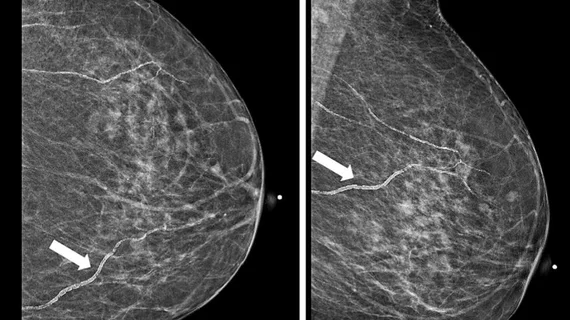Nearly 25% of women with breast arterial calcifications on mammo develop heart disease
Routine mammograms could provide valuable insight into the likelihood that a woman will develop cardiovascular disease in the future.
In recent years, breast arterial calcifications (BACs) visualized on mammograms have been a topic of conversation among medical experts, as multiple studies have indicated that there may be a link between the radiologic finding and cardiovascular disease. Now, new research set to be presented this week at the 2024 Annual Meeting of The Menopause Society suggests that nearly a quarter of women with BACs on imaging will develop cardiovascular disease.
Specifically, the research highlights associations between BACs and atherosclerotic cardiovascular disease. The longitudinal study followed nearly 400 women for 18 years and found that 23% with BACs on their mammogram developed cardiovascular disease, compared to just 13% of those without.
Although the finding is not particularly new, the longitudinal nature of the study is, lead author Hannah Daley, from Drexel University College of Medicine in West Reading, Pennsylvania, noted in a release.
“This study aimed to assess the longitudinal association between breast arterial calcifications and atherosclerotic heart disease. Based on what we found, we believe the presence of breast arterial calcifications on a mammogram should be routinely reported,” Daley said.
Prior research signaled that many referring providers are not familiar with the association between BACs and cardiovascular disease. However, one recent study revealed that once providers were made aware of the link, they felt that it should be included in radiology reports.
Currently, radiologists are not required to report the presence of BACs, but the call for them to do so has been growing, as cardiovascular disease represents a significant risk to women’s health.
“Studies like this one are encouraging because they provide information on a tool that healthcare professionals could use to determine the risk of heart disease in women,” says Dr. Stephanie Faubion, medical director for The Menopause Society. “In addition, it reinforces that the risk factors for cardiovascular disease in women are different than for men.”
The Centers for Disease Control and Prevention estimates that 44% of women in the United States have some form of heart disease. The condition is the leading cause of death among women in the U.S.
The 2024 Annual Meeting of The Menopause Society is taking place from September 10-14 in Chicago.

